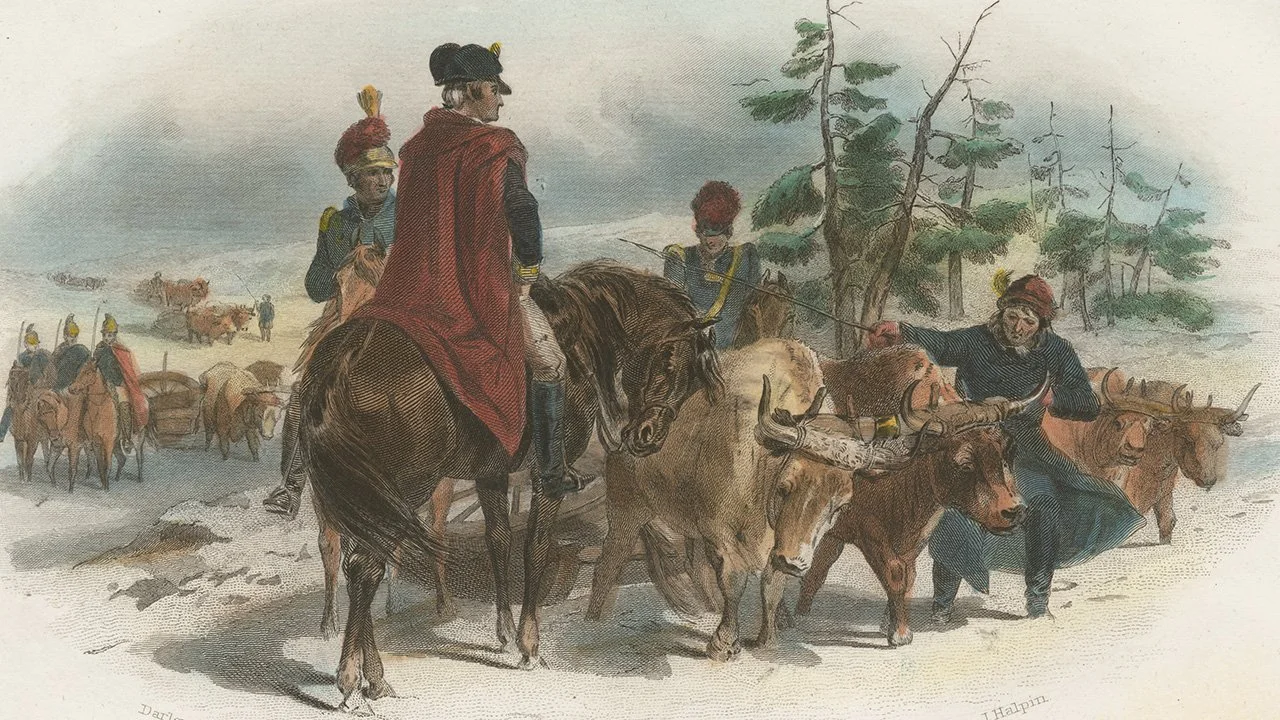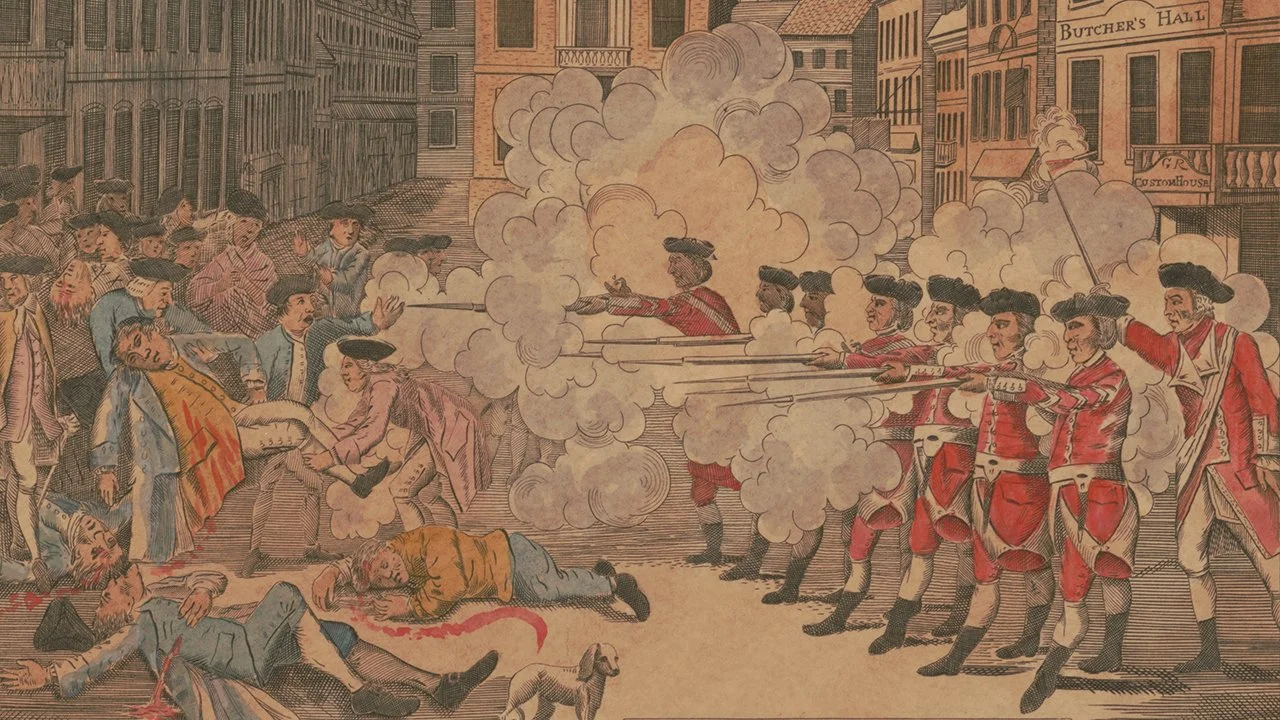The Origins of the Bill of Rights
When the Constitutional Convention met in the summer of 1787, the primary goal of the delegates was to fix the weaknesses in the Articles of Confederation. Most of the discussion focused on how our new government would operate, not on the individual rights of the people. George Mason of Virginia introduced a motion to adopt a Bill of Rights, but the suggestion was quickly dismissed.
The Continental Army Retakes Boston
The siege of Boston was the longest in our nation’s history, running from April 19, 1775, to March 17, 1776. The guns brought from Fort Ticonderoga by Colonel Henry Knox gave General George Washington what he needed to force the British to evacuate.
Henry Knox and His Noble Train of Artillery
The siege of Boston, which began after the Battles of Lexington and Concord, could not have been broken by the colonists without long range artillery. Fortunately, the Continental Army had a large supply of these guns 300 miles away at Fort Ticonderoga.
The Battle of Bunker Hill
During the Battle of Bunker Hill, the first major battle against the British, the American militia showed a grit and determination that impressed all. Although the colonists did not hold the field, the Redcoats paid dearly for their gains.
The War for Independence Begins
The Battles of Lexington and Concord, fought on April 19, 1775, marked the start of the American Revolution and colonists’ armed struggle to control their destiny. Brave Minutemen demonstrated that the strong words spoken and written up to that point had not been idle talk. As John Adams remarked, the die was cast and there was no turning back.
The Articles of Confederation
The Articles of Confederation were the foundation for our nation’s first unified government. However, the inherent weaknesses in the Articles gave our Founding Fathers insight into what America needed in its federal government.
Lexington and Concord, Minutemen in Arms
The Battles of Lexington and Concord, fought on April 19, 1775, marked the start of America’s war for independence and were the culmination of a series of troubles between England and her American colonies.
The Legacy of Paul Revere
Forty-three years after Paul Revere’s death, Henry Wadsworth Longfellow published “Paul Revere’s Ride,” moving Revere and his midnight ride from obscurity into the pantheon of American legend.
The Midnight Ride of Paul Revere
The evening of April 18, 1775, Paul Revere and William Dawes began a long ride through the countryside, telling every house along the way “the Regulars are coming out!” Amazingly, before the British were on the march, towns 25 miles away were aware of the pending action.
A Historic Gathering at the First Continental Congress
In 1774, the First Continental Congress brought together many influential leaders from colonial America. 56 men, including George Washington and John Adams, met to formulate a response to England’s Coercive Acts, which closed the port of Boston and revoked Massachusetts’ colonial charter in response to the Boston Tea Party. This historic gathering was the first time complete separation from England was openly discussed.
The Boston Tea Party
One of the most iconic moments in American history, the Boston Tea Party was emblematic of the colonies’ resistance to British oppression. Taxes imposed by the Townshend Acts and the Tea Act would lead the Sons of Liberty to toss 92,000 pounds of tea, valued at almost $2 million today, into the Boston Harbor.
The Boston Massacre Trial and Its Aftermath
Tom Hand, creator and publisher of Americana Corner, discusses the Boston Massacre, a tragic affair that can be traced to the British parliament’s passing of the Townshend Acts, and why it still matters today.
The Boston Massacre
Tom Hand, creator and publisher of Americana Corner, discusses the Boston Massacre, a tragic affair that can be traced to the British parliament’s passing of the Townshend Acts, and why it still matters today.
The Stamp Act Congress
Representatives from the 13 colonies met during the Stamp Act Congress of 1765 to discuss their formal response to the Stamp Act, which placed a direct tax on virtually all printed materials in America. This meeting was the first time the colonies came together to resist the British Empire.
Fort Ticonderoga and America’s Quest for Independence
During the American Revolution, Fort Ticonderoga was a strongpoint on the natural waterway between the American colonies and British-controlled Canada. The cannons captured there provided the heavy artillery General Washington needed to intimidate the British out of Boston.
The Albany Congress
Colonists convened at the Albany Congress of 1754 to discuss how to help the British improve their relationship with the Iroquois Confederation. More importantly, delegates also discussed joint efforts to enhance the safety of the colonies and other common interests, which led to the proposed Albany Plan, calling for a unified colonial government.
The French and Indian War
In the 1750s, American colonists were happy to be part of the British Empire. Were it not for the French and Indian War, fought between England and France from 1754 to 1763, America might not have sought her independence.
George Washington’s Farewell Address: Part Three, Debt and Neutrality
George Washington recognized that a nation with excessive debt would struggle to survive. Washington also knew from experience that all nations did what was in their own best interest, and encouraged America to be a friend to all and an enemy to none.






















